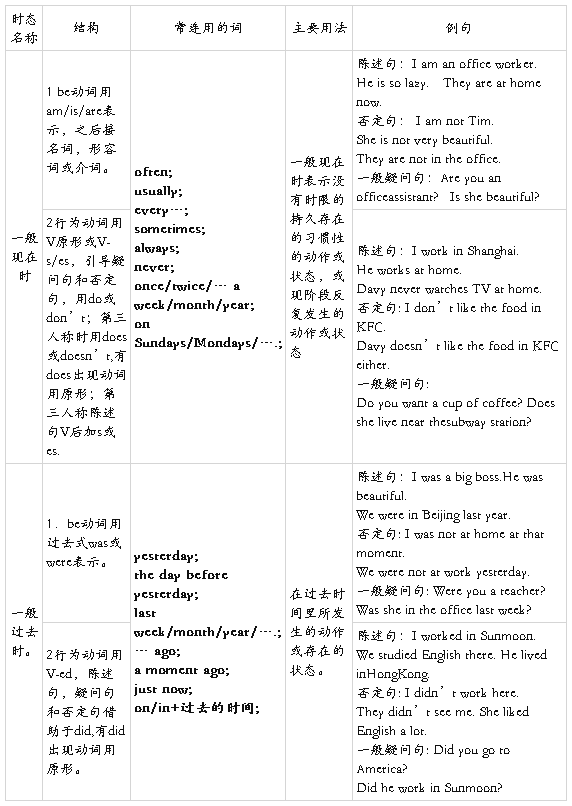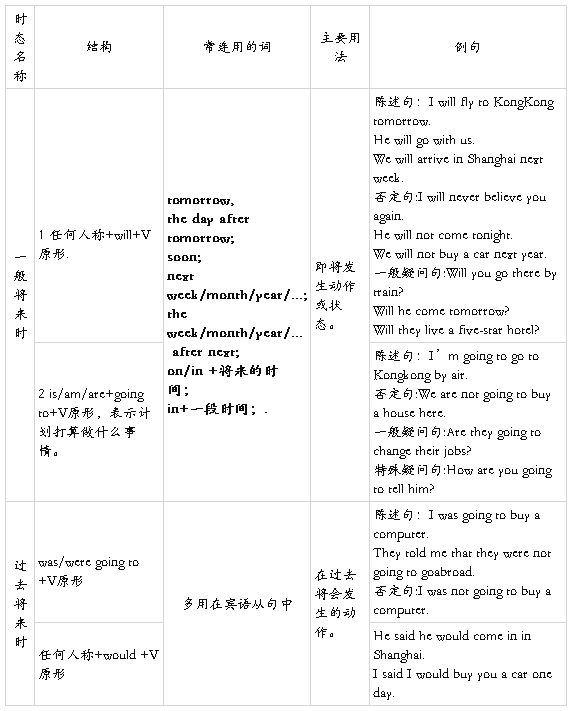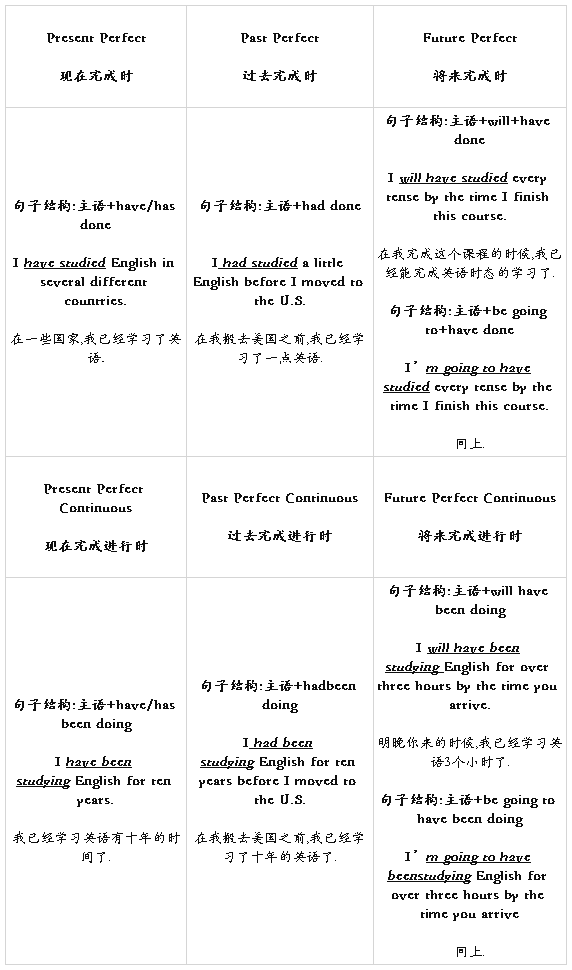英语时态总结
英语时态总结
时态(Tense)是表示行为、动作和状态在各种时间条件下的动词形式。因此,当我们说时态结构的时候,指的是相应时态下的动词形式。
英语时态分为16种:一般现在、一般过去、一般将来、过去将来时,以及这四者的进行时、完成时和完成进行时。在这里,我们重点讲解一下最常见的11种时态的用法和注意事项。
1. 一般现在时:小学就开始学这个,大家都会吧,有几点强调一下我们就走。
A) 表示现在发生的动作、情况、状态和特征。If it is not too much trouble, I would like a cup of tea.
B) 习惯用语:这个要在平时自己积累,因为习语太多,我不做过多解释。 Ie: Believe it or not, his discovery had created a stir in scientific circles.
口语中常说believe it or not,意思是:“信不信由你”,“我说的是真的”。believe it or not是一个固定说法,相当一个插入语,短语中的believe没有词形变化。这点要注意,以后会教你们动名词的用法,到时候会牵涉到主语的问题。
C) 经常性、习惯性动作。
Ie:He always helps others. (他总是帮助别人。)
D) 客观事实和普遍真理。尤其要注意,如果前后文不是一般现在时,则无法保持主句、从句时态一致.ex: He said that the sun rises in the east.这个句子要注意,到了以后的定语从句经常会有这样的问题,具体细节到 时候在说,不过你们要先有这样的概念:客观事实无论谓语的时态是什么都用一般现在时。
E) 表示一个按规定、计划或安排要发生的动作,(仅限于某些表示“来、去、动、停、开始、结束、继续”等的动词 )可以与表示未来时间的状语搭配使用。常见的用法是:飞机、火车、轮船、汽车等定期定点运行的交通方式。
ex: When does the plan leave?这个句子注意一下,就是这么用的,有人会注意到这样的问题: The plane leaves at 3 o’clock this afternoon.为什么不用将来时,对了,很奇怪,但就是这么用的。
F) 在时间和条件状语从句里经常用一般现在(有时也用现在完成时)表示将来事情。
Ie: When you finish the report, I will have waited for 3 hours.(完成时,往下看会出现)
2. 现在进行时(be doing) 的用法:上了初一就教这个吧,比一般现在还简单。表示现在正在做的动作,但要注意有的动词不能用于进行时,这类词称为短暂性动词,如,open, borrow等等,在完成时态常常会碰到,平时要注意积累。
3. 现在完成时(have done):重要考点,初二以后几乎都是完成时态。
A) 表示动作到现在为止已经完成或刚刚完成。
ex: I have just finished my homework.
B) 表示从过去某时刻开始,持续到现在的动作或情况,并且有可能会继续延续下去。此时经常用延续性动词。时间状语常用since加一个过去的时间点,或for加一段时间,或by加一个现在时间。这里联系进行时,他们都一样,不能用短暂性动词,★★★☆☆考点。
C) 表示发生在过去,但对现在仍有影响的动作或情况。通常用点动词,如:arrive, begin, find, give, lose等。
例:John has broken his left leg.(约翰摔断了左腿。)
注意:
A) 现在完成时是联系过去和现在的纽带。现在完成时和过去时的区别在于:现在完成时强调动作的动态,或受动态的影响,是动态的结果,对现在有影响;过去时只表示过去的某个具体时间里发生的动作,与现在没有联系。
例:He worked in that hospital for 8 years.(他曾经在那家医院工作了8年。这只是讲述一个过去的事实,他现在已经不在那家医院了。)
He has worked in that hospital for 8 years.(他已经在那家医院里工作了8年。表示他从过去开始工作,一直工作到现在,现在仍在那家医院工作。)
B) 因为含有for加一段时间或since加一个时间点这样的时间状语的完成时,有动态和延续性的特点,所以不能使用终端动词或瞬间动词。
例:My sister has been married for 5 years.(过去分词做表语表示状态,可以延续)
My sister has married. Don't disturb her.(终端动词)
C) 在"this is the first/ second/ third…… time that……"句型里要求用完成时。 例: This is the second time that the products of our company have been shown in the International Exhibition. (这是我公司产品第二次参加国际展览会。)
D) 句型"It is/ has been……since"所使用的两种时态都正确。
例:It is/ has been 10 years since I last saw him.(从我上次见到他以来已经10年了。)
E) 在"no sooner than"、"hardly/ scarcely ……when"、"before"、"prior to"等句型中,主句要求完成时。
例:I haven't met that professor prior to today.(以前我从未见过那位教授。)
4. 现在完成进行时(have been doing):和现在进行时很像
1) 用法:表示某一动作开始于过去某一时间,延续或重复地出现至今,或将继续延续至将来。
例:We have been working on this project for over a month now.(到目前为止,我们一直在处理那个项目,已经花了一个多月时间了。)
2) 注意事项:与现在完成时相比,现在完成进行时更强调:在从过去到现在的时间里,动作或状态一直持续或一直反复出现。
5. 一般过去时
A) 表示过去某个时间发生的动作或情况。
ex:I went to Beijing last year.
B) 表示过去习惯性动作。特别是由would/ used to do表达的句型,本身表示的就是过去时。
ex: I used to live here.(注意used to 和be used to 的区别,used to表过去常常,be used to 表示习惯于,前者to是不定式符号,后者则是介词,后接名词、动名词、代词)
C) 有时可代替一般现在时,表达一种婉转、客气、礼貌、商量的语气。 ex: Would you mind my sitting here?(您介意我坐在这里吗?)
Could you pass me the pen?
注意:
A) 注意时间状语的搭配。一般过去时的时间状语应该是表示过去某个时间的词或词组,如:yesterday, last month, in 1999, two days ago等,绝对不可与recently,
in the past 10 years, this month等连用,因为这样的时 间状语都与现在有关系,应该用现在完成时或一般现在时。注意,到了初二将会是★★★★☆考点,不会不行,逃不了的,几乎每次都考。
B) used to do的否定形式和疑问形式很特别:你怎么写都正确。以否定形式为例:used not to do, didn't used to do, didn't use to do都对。
6. 过去完成时(had done)
用法:表示在过去的某个时间或动作以前已经发生的动作或已经存在的状态。就是我们常说的:表示"过去的过去的动作或状态"。
画一条时间轴过去完成__●_一般过去_◇_一般现在___○______
2) 注意事项:“过去的过去”这种逻辑关系常通过上下文体现出来,而不一定受某个时间状语的限制。
ex: There had been some one in our room just now, because I noticed a burning cigarette end on the floor when we opened the front door.
7. 过去将来时(would/ should do) 表示从过去的某个时间看将要发生的事。其实和将来时没什么区别啦。
ex: I said on Thursday I should see my friend the next day.宾从、直引经常碰到这样的例子,注意。
8. 过去进行时(was/ were doing)
A) 表示在过去一个比较具体的时间正在发生的动作。
ex: I was doing my homework at this time yesterday.
B) 如果when, while这样的时间状语引导词所引导的主从句之一是一般过去时,则另一个句子常用过去进行时。
ex: I was washing my hair when you knocked at the front door.
9. 一般将来时
A) 基本结构是will / shall do。古英语认为will用于第二、三人称,shall用于第一人称,但后来没做硬性规定,will比较常用。I will be home at 10.
B) 有些动词,如:arrive, be close, come, do, done, go, have, leave, open, play, return, sleep, start, stay等,用于一般进行时,并且通常与一个表示将来时间的时间状语连用,可以表示将来时。初一接触比较 多的是be going to,后面的包括will/shall到了后来才出现,其他如sleep很少见,初中阶段我几乎没见过sleep这么用的, leave, come, arrive也常见
ex: My mother is coming to visit me next week and is staying here until May.
C) 表示“即将、正要”时,可用be about to do。强调近期内或马上要做的事,后常与when连用。ex: I was about to speak when you interrupted me.
D)"be to do"的5种用法:
a) 表示“按计划、安排即将发生某事或打算做某事”。
例:She is to be seen in the lab on Monday.(星期一你准会在实验室见到她。) b) 该做或不该做的事情(语气上接近于should, must, ought to, have to),表示一种命令、规劝性语气。
例:You are to go to bed and keep quiet, kids. Our guests are arriving in less than 5 minutes.(孩子们,你们必须 上床睡觉,不准吵闹。我们的客人5分钟之内就要到了。)
c) 能或不能发生的事情(接近can, may)
例:How am I to pay such a debt?(我怎么可能还得起这么大的一笔债呢?)
d) 不可避免将要发生的事情,后来将要发生的事情。
例:I assure you that the matter _______ as quickly as possible. Have a little patience.
A. will be attended B. will be attended to
C. is attended D. is attended to
will be attended to关键的一点是:attend表示“处理,解决”时是不及物动词,必须与to连用。另外,从上下文看,事情显然尚未解决,所以应该用将来时的被动语态。答案是B。
A) is to be B) can be C) will be D) has been
答案是A) is to be。全句的意思是:“如果要避免食品短缺,就必须作出更大努力来增加农业产量。”
E) 同样可以表示“正要、将要”的意思的句型是be on the point of doing。 The coach is on the point of giving up the game because our team has been scored 7 points. 注意:
在 以if, when, as long as, as soon as, after, before, in case, until, unless 等连词以及具有连词作用的副词(immediately, the moment, directly)等引导的状语从句,一般用现在时代替将来时。强调 延续性或动态时,可用完成时。
例:I hope his health will have improved by the time you come back next year.(我希望到明年你回来的时候,他的身体已经好多了。)
10. 将来进行时(will be doing) 调在将来的某个具体时间正在发生的动作或事情。
ex: Don't worry, you won't miss her. She will be wearing a red T-shirt and a white skirt at that time.
11. 将来完成时(will have done) 表示从将来的某一时间开始、延续到另一个将来时间的动作或状态,或是发生在某个将来时间,但对其后的另一个 将来时间有影响的动作或状态。就好象把现在完成时平移到时间轴的将来时时段一样。其用法从和过去及现在有关,变成了和将来及将来的将来有关。
ex: It is reported that by the end of this century the people of Chinese will have increased by 2 billion.
第二篇:英语十六时态表格总结(很全面)
英语时态表 —— 一般现在时、一般过去时

英语时态表——一般将来时、过去将来时

英语时态表——现在进行时、过去进行时

英语时态表 —— 现在完成时、过去完成时

英语时态表 —— 英语时态举例!


英语时态表 —— 详细讲解-一般现在时
通常以动词原形表示。主语为第三人称单数时,用现单三形式。
动词be和have(表示“拥有”)各人称的单数形式为:
第一人称单数 第二人称单数 第三人称单数
Have Have Have Has
Be Am Are is
一般现在时的否定式、疑问式和简单回答形式如下:
动词be 与 have(表示“拥有”):否定式直接把not放在动词之后,疑问式直接把动词放在主语之前,见下表:
否定式 疑问式
Be Have Be Have
I am not (I’m not)… I have not (haven’t)… Am i…? Have i…?
You are not (aren’t)… You have not (haven’t)… Are you…? Have you…?
He is not (isn’t)… He has not (hasn’t)… Is he …? Has he …?
动词be 的否定疑问式和简单回答:
否定疑问式 肯定回答 否定回答
Am I not (aren’t i)…? Yes, you are. No, you aren’t
Are you not (aren’t you)…? Yes, I am. No, I’m not.
Is he not (isn’t he)…? Yes, he is. No, he isn’t
动词be 与 have(表示“拥有”):否定式直接把not放在动词之后,疑问式直接把动词放在主语之前,见下表:
否定式 疑问式
Be Have Be Have
I am not (I’m not)… I have not (haven’t)… Am i…? Have I …?
You are not (aren’t)… You have not (haven’t)… Are you …? Have you…?
He is not (isn’t)… He has not (hasn’t)… Is he …? Has he …?
动词have(表示“拥有”) 的否定疑问式和简单回答:
否定疑问式 肯定回答 否定回答
Have I not (haven’t i)…? Yes, you have. No, you haven’t.
Have you not (haven’t you)…? Yes, I have. No, I haven’t.
Has he not (hasn’t he)…? Yes, he has. No, he hasn’t.
注意:have 作为行为动词则只能按照行为动词的规则变化。
行为动词(以study为例)一般现在时的否定式、疑问式和简单回答(注意要加助动词do/does)
否定式 疑问式
I do not (don’t) study Do I study
You do not (don’t) study Do you study
He does not (doesn’t) study Does he study
否定疑问句式 简单回答(肯定/否定)
Do I not (Don’t I) study…? Yes, I do. No, I don’t.
Do you not (Don’t you) study…? Yes, you do. No, you don’t.
Does he not (Doesn’t he) study…? Yes, he does. No, he doesn’t.
英语时态表 —— 详细讲解-现在进行时、一般过去时
由助动词be +现在分词构成。其中be有人称和数的变化,有三种形式:第一人称单数用am, 第三人称单数用is, 其他用are。
现在进行时的否定式是:直接在助动词be后面加上not;疑问式是:把助动词be提到主语之前。以study 为例:
否定式 疑问式
I am not studying Am I studying?
You are not studying, Are you studying?
He is not studying. Is he studying?
一般过去时
一般过去时通常由动词过去式表示。一般过去时的否定式、疑问式和简单回答形式要用助动词do 的过去式did, 同时注意实义动词要用原形。以study 为例,其否定式、疑问式和简单回答形式如下:
否定式 疑问式
I did not (didn’t) study…. Did I study…?
You did not (didn’t) study…. Did you study…?
He did not (didn’t) study…. Did he study…?
否定疑问式 简单回答(肯定/否定)
Did I not (Didn’t I) study…? Yes, you did. No, you didn’t.
Di you not (Didn’t you) study…? Yes, I did. No, I didn’t.
Did he not (Didn’t he) study…? Yes, he did. No, he didn’t.
英语时态表 —— 详细讲解-过去进行时、过去完成时
过去进行时
由助动词be 的过去式+现在分词构成。其中be有人称和数的变化,第一、第三人称单数用was,其他用were.
1)过去进行时动词主要表示在过去某一时刻或某一段时间内正在进行或持续进行的动作。过去进行时经常与过去时配合使用。例如:
This time yesterday, we were having an English lesson. 昨天这个时候,我们正在上英语课。
The teacher was giving us a lesson when Tom walked into the room. 老师在给我们上课时,汤姆走进教室。
While we were having supper, all the lights went out. 我们吃饭的时候,灯灭了。
He was reading while she was setting the table. 她摆桌子时,他在读书。
It was getting dark. The wind was rising. 天渐渐黑下来了。风势增强了。
2)过去进行时动词常用always, continually, frequently 等词连用,表示过去经常发生的行为。这种用法表明带有的感情色彩。例如:
The two brothers were frequently quarreling when they were young. 两兄弟小时候常吵架。
In Qing Dynasty, China was always making concessions to western powers. 清朝时,中国总是对西方列强妥协。
过去完成时
一律用had + 过去分词构成。
用法:
1)表示发生在过去某一时间或动作之前的事情,即“过去的过去”。用过去完成时,必须有一个过去的时间或动作来作参照,说明在此之前某事已发生。如果两个动作都是在过去发生的,先发生的用过去完成时,后发生的用一般过去时。例如:
She told me she had been there three times before. 她告诉我她以前到过那里三次。(“去过”发生在“告诉”之前)
How long had he taught here by the end of last term? 到上学期末为止,他在这里教学多长时间啦?(“教学”发生在上学期末结束之前)
When we arrived, the football match had already begun. 我们到的时候,足球赛已经开始了。
She had visited China twice before she came this year. 她今年来中国之前已访问过中国两次了。
2)过去完成时动词可以表示过去某一时刻之前发生的动作或呈现的状态,这一动作一直持续到过去这一时刻或将继续下去。例如:
By the middle of last month, I had lived in Beijing for five years. 到上月中旬,我已在北京住了五年了。
By six o’clock they had worked for eight hours. 到六点为止,他们已工作八小时了。
When I came to Shanghai, he had been there for a long time. 我到上海时,他在那里很长时间了。
3)过去完成时动词常用于间接引语和虚拟语气,我们以后会详细讲述。
4)此外,过去完成时常用于 no sooner…than… 和 hardly(scarcely) …when… 这两个句型,前面部分用过去完成时,后面部分用一般过去时。例如:
No sooner had he stolen the purse than he was caught red-handed. = He had no sooner stolen the purse than he was caught red-handed. 他刚偷到钱包就被当场抓获。
Saddam had hardly realized what was happening when he was captured. = Hardly had Saddam realized what was happening when he was captured. 萨达姆还没有意识到在发生什么事情就被抓获了。
英语时态表 —— 详细讲解-过去完成进行时、一般将来时
过去完成进行时
had been + 动词的现在分词。
用法:表示一直持续到过去某个时间的行为动作,此行为动作或刚结束、或还没结束(可以从上下文看出)。这一时态经常与一般过去时一起使用。例如:
When he came in, I had been trying to repair the TV for a couple of hours. 他进来的时候,我一直在努力修理电视机好几个小时了
The roads were dangerous. It had been raining for two whole days. 道路很危险。雨一直下了两整天。
They were tired because they had been digging since dawn. 他们累了,因为从天亮开始他们就一直在挖。
The boy was delighted with the new mountain bike. He had been hoping for one for a long time. 那男孩得到一辆新山地自行车很高兴。很长时间来他一直希望有一辆。
一般将来时
一般将来时动词表示将来发生的动作或情况。主要有以下几种表现形式:
(1)shall/will + 动词原形
表示单纯的将来,不涉及主语的主观意愿。第一人称I, we用shall 或will,其余用will. 其否定式、疑问式和简单回答形式如下:
否定式 疑问式
I shall/will not study…. Shall I study…?
You will not study…. Will you study…?
He will not study…. Will he study…?
否定疑问式 简单回答(肯定/否定)
Shall I not (shan’t i) study…? Yes, you will. No, you won’t.
Will you not (Won’t you) study…? Yes, I shall/will. No, I shan’t/won’t.
Will he not (Won’t he) study….? Yes, he will. No, he won’t.
例如:
I shall be twenty years old next year. 我明年二十岁。
The sky is black. I think it will rain. 天黑下来了。我想可能会下雨。
You will meet him at the station this afternoon. 你下午会在车站碰到他。
The train will arrive soon. 火车快要到了。
When shall we see you next time? 我们下次什么时候能看见你呢?
He probably won’t go with us. ??他大概不能和我们一起去。
注意:
1)shall, will的缩写形式为’ll, 如I’ll, you’ll, he’ll 和she’ll等。
2)will 用于第一人称时,可以表示将来的意愿、决心、允诺、命令等;shall用于第二、三人称时,可以表示说话人的将来的意愿。例如:
I will give you a new pen for your birthday. 我将送你一支新钢笔作为生日礼物。(允诺)
I will take the college entrance examination. 我将参加大学入学考试。(决心)
Shall I open the window? 我打开窗户好吗?(征求允诺)
You shall have the book as soon as I get it. 我一拿到书就给你。(说话人的允诺)
The enemy shall not pass. 决不让敌人通过。(说话人的保证)
I will do my best to help you. 我愿意尽力帮助你。(意愿)
Nobody shall be late for the meeting. 任何人开会都不能迟到。(说话人的命令)
(2)be going + 动词不定式
1)这种结构表示主体现在打算在最近或将来要做某事。这种打算往往是事先考虑好的。例如:
My brother is going to learn English next year. 我哥哥准备明年学英语。
I am going to meet Tom at the station at six. 我六点钟要到火车站去接汤姆。
She is not going to be there. 她不会到那儿去的。
When are you going to finish your work? 你的工作什么时候做完?
He is going to stay a week. 他准备呆一星期。
We are going to call a meeting to discuss it. 我们准备开个会来讨论一下。
2)这种结构还可以表示说话人根据已有的迹象认为非常可能即将发生某事。例如:
Look at these black clouds?it is going to rain. 看这些乌云?要下雨了。
I think it is going to snow. 我看要下雪。
I am afraid I am going to have a bad cold. ??恐怕我要得重感冒。
英语时态表 —— 详细讲解-将来进行时
将来进行时
shall/will be + 现在分词
用法:将来进行时动词表示在将来某一段时间内将会发生的动作。
This time next week we shall be working in that factory. 下星期这时候,我们将在那个工厂劳动。
When I get up tomorrow morning, my mother will be getting breakfast for me. 当我明天早晨起床时,我妈妈将在为我准备早饭。
I will be seeing him next month. 我下个月将要见他。
Tomorrow we will be going to the village fair.????????我们明天去赶集。
We will be taking our holiday at the seaside in July. 七月份我们要去海边度假。
一般将来时与将来进行时都表示将来,那么如何区别一般将来时和将来进行时呢?将来进行时不表示个人意愿,强调主观上感觉某事即将发生,并对这一事情有着期待,感情色彩较浓,强调动作。一般将来时主要是对某一事情即将发生做一个事实性的说明或陈述,强调事实或意愿。
英语时态表 —— 详细讲解-过去将来时、将来完成时
过去将来时
(1)由should/would + 动词原形构成。第一人称用should; 第二、三人称用would。美国英语所有人称一律用would. should/would 的简略形式为’d, 如I’d, you’d; would not 和should not的简略形式分别为wouldn’t 和shouldn’t.
(2)过去将来时表示从过去某时间看将要发生的事情,多用在宾语从句中。还可以表示过去的倾向或过去经常发生的事情。如:
They asked me if I would go to Guangzhou soon. 他们问我是否很快要去广州。
She told me she would come again next week. 她和我说她下周还来。
I told him to leave immediately, but he wouldn’t. 我告诉他马上离开,但他不。
He’d play the violin when he was in low spirits. 他情绪低落的时候,就拉小提琴。
When I was in college, I would find a part-time job during the summer holidays every year to earn my tuition. 我上大学的时候,每年暑假都找份临时工挣学费。
(3)其他表示过去将来时的结构:
将来完成时
shall/will + have + 过去分词
用法:将来完成时动词主要表示在将来的某一时刻或将来的某一时刻之前完成的动作,这一动作也可能继续进行。例如:
By seven o’clock this afternoon we shall have got to Shanghai if the train keeps good line. 如果火车运行正常,我们今天下午七点就到上海了。
Before bedtime Xiao Ming will have completed his work. 到上床睡觉的时候,小明会做完他的工作(或作业)。
By February next year this foreign expert will have been here on this job for five years. 到明年二月,这个外国专家在这儿做这项工作就满五年了。
By Sept. 20## Beijing will have held/hosted the Olympic Games. ??到20##年9月,北京将举行完了奥运会。
-
高中英语时态总结
一般现在时经常发生或反复发生的动作现实的情况或状态永恒的真理Sheworkseighthoursaday.Heisalawstud…
-
高中英语时态总结
一、现在进行时与一般现在时的区别(1)现在进行时强调目前正在进行的动作,而一般现在时强调经常性或习惯性的动作。如:I’mreadi…
-
9种英语时态总结归纳 高考适用
9种英语时态总结归纳时态(Tense)是表示行为、动作和状态在各种时间条件下的动词形式。因此,当我们说时态的时候,指的是相应时态下…
-
PEP小学英语时态总结
小学英语时态小结一、一般现在时:用来叙述经常性发生的事情、习惯和爱好等,时间词有:sometimes\often\usually\…
-
小学英语时态总结
一般现在时标志词:always(总是)usually(通常)often(经常)sometimes(有时)never(从不)ever…
-
英语时态总结(完整)
(1)一般现在时基本形式(以do为例):第三人称单数:does(主语为非第三人称单数);肯定句:主语+动词原形+其他;Hework…
-
英语时态总结(完整)
英语共有十六个时态、四个体。(注:四个体为——一般、进行、完成、完成进行。)英语中的四个体相当于法语、西班牙语以及所有印欧语系罗曼…
-
英语各种时态总结
时态-定义英语语法中的时态(tense)是一种动词形式,不同的时态用以表示不同的时间与方式。是表示行为、动作和状态在各种时间条件下…
-
英语各种时态总结
时态-定义英语语法中的时态(tense)是一种动词形式,不同的时态用以表示不同的时间与方式。是表示行为、动作和状态在各种时间条件下…
-
初中英语时态总结
一、一般现在时1.概念:经常、反复发生的动作或行为及现在的某种状况。2.时间状语:Always,usually,often,som…
-
高中16种英语时态总结归纳
时态(Tense)是表示行为、动作和状态在各种时间条件下的动词形式。因此,当我们说时态结构的时候,指的是相应时态下的动词形式。英语…